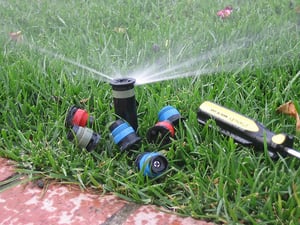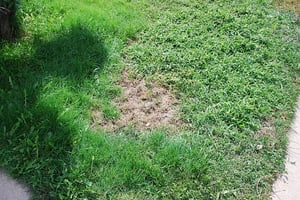Summer is in full swing and, thanks to your irrigation system, your lawn looks lush and inviting without you having to do a thing.
Or do you?
Irrigation systems are designed to be low maintenance, so it’s tempting to simply ‘set and forget’ them. But no equipment is invincible.
Periodic inspections throughout the irrigation season will prevent and/or minimize problems so your lawn will stay looking great.
Inspecting your irrigation system is not difficult. Here are some irrigation maintenance tips and tricks:
1. Check Your Irrigation Sprinkler Heads
 Every week or two, or once a month at the very least, be prepared to walk through your property and check all of your sprinkler heads to be sure they are still in good condition and working properly.
Every week or two, or once a month at the very least, be prepared to walk through your property and check all of your sprinkler heads to be sure they are still in good condition and working properly.
Most sprinkler timers that are at most 10 years old have a test cycle, which makes this task easy. Just set your timer to run on ‘test’ and it will run for just a few minutes, one irrigation zone at a time.
When running on 'test' the timer will leave enough time between zones for you to inspect any heads that don’t appear to be working properly. Here is what to look for:
- Broken heads. Sprinkler heads are hard to see. If a head isn’t retracting properly it can easily get run over by a lawn mower and break. If you see a geyser of water shooting up where there should be a sprinkler head, you probably have a broken head. These should be replaced immediately.
- Clogged heads. Dirt, mulch, or minerals from hard water can plug up a sprinkler head or rotor nozzle, preventing the water from flowing through it. Check the screen inside the stem of the spray head and clean it off if it is plugged. If the orifice itself is plugged, you may be able to push out the debris with an awl or screwdriver. If this doesn’t work, just replace the head.
- Leaky heads. Sprinkler heads have a rubber seal that wears down over time. At some point you may notice leakage from your heads. A little bit of leakage is not the end of the world, but if it starts looking like a little river it’s time to replace the unit.
- Stuck heads. When working properly, sprinkler heads should pop up during use and retract when the water flow shuts off. As they wear or get clogged with dirt, they sometimes get stuck in the up position. Often you can tap them with your foot and get them to go down but eventually they’ll stick for good. You can probably guess by now that this is a good reason to replace the head.
A typical rotor or head should last 7 to 8 years. Soil type can affect head longevity. Sandy soil is more corrosive than clay or loam, so if you have sandy soil you may need to change your heads more frequently.
The biggest factor in head longevity, however, is quality. We have seen some heads still in use after 20 years and some fail after only two. That’s why we use contractor grade equipment on our irrigation systems. It is important, too, to note that brand name is not always an indication of quality.
The irrigation heads available in most retail outlets are not the same quality as the components we install, even when the brand names are the same.
2. Look for Tell-Tale Signs in Your Turf
In addition to physically inspecting your irrigation heads, you will want to be sure your sprinklers are running long enough to do the job right.
If you pay close attention, your grass itself will tell you whether your sprinklers are running long enough and, if not, how to adjust your system.
Brown areas in your yard indicate not enough water. Look for a pattern. If it’s just brown in one area, you’ll want to check for a clogged or broken head.
If you have many brown areas, your sprinklers may not be running long enough to properly hydrate your lawn.
Another indication of under-hydration is a limp lawn. If the blades of grass stay down and don’t spring back up when you walk across your lawn, you need to water more.
On the other hand, really wet, swampy areas indicate too much water. If it’s localized, it’s probably due to a major leak or broken head. Otherwise, you may want to cut back on watering times.
3. Use The Cat Food Can Test
 If you are not sure how much water you’re giving your lawn, the Cat Food Can Test is an easy way to find out. Just place a couple of empty cat food or tuna cans on your lawn. Then turn the sprinklers on for 30 minutes and measure the water.
If you are not sure how much water you’re giving your lawn, the Cat Food Can Test is an easy way to find out. Just place a couple of empty cat food or tuna cans on your lawn. Then turn the sprinklers on for 30 minutes and measure the water.
A rain gauge will work, too, but the cans are simple and accurate enough to show how much water is going onto your lawn each half hour of use.
As a rule of thumb in the Memphis area, we recommend putting down 1/2” of water every couple of days throughout the summer months. As temperatures drop in the fall you can taper back from that amount.
We don’t normally recommend watering every day because doing so encourages plants to develop shallow roots. You want your roots to be deep and strong for optimal resistance to drought and disease. Also, plants get oxygen from their roots, not their leaves. Keeping the soil constantly wet can deprive them of this nutrient.
Another option is to get a smart panel for your irrigation system. Smart irrigation technology will automatically deliver the correct amount of water for your landscape.
However, you will still always want to keep an eye on your lawn and check your sprinkler heads regularly to be sure they are doing their job.
Want More Than Just Irrigation Maintenance Tips?
Irrigation maintenance tips are great for diagnosing a problem, but you might need more than just a Band-Aid solution.
Call one of our irrigation specialists at 901-755-3207 or fill out this simple contact form.


